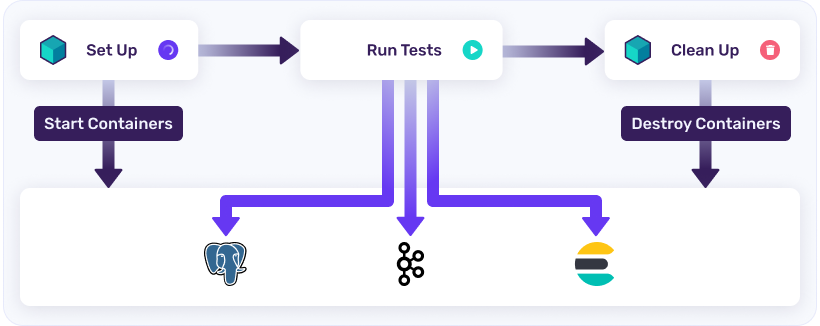Testing with testify
To write tests in Go, @stretchr/testify is an awesome library. It has suite, require and assert.
Note
Always use
_testprefix on packages for writing tests but in case of internal tests in which you have access to private package members use_internal_test.goas filename.
Define the suite, and absorb the built-in basic suite functionality from testify - including a T() method which returns the current testing context
type ExampleTestSuite struct {
suite.Suite
VariableThatShouldStartAtFive int
}Make sure that VariableThatShouldStartAtFive is set to five before each test
func (suite *ExampleTestSuite) SetupTest() {
suite.VariableThatShouldStartAtFive = 5
}All methods that begin with Test are run as tests within a suite.
func (suite *ExampleTestSuite) TestExample() {
assert.Equal(suite.T(), 5, suite.VariableThatShouldStartAtFive)
suite.Equal(5, suite.VariableThatShouldStartAtFive)
}In order for go test to run this suite, we need to create a normal test function and pass our suite to suite.Run.
func TestExampleTestSuite(t *testing.T) {
suite.Run(t, new(ExampleTestSuite))
}SetupAllSuite has a SetupSuite method, which will run before the tests in the suite are run.
type SetupAllSuite interface {
SetupSuite()
}SetupTestSuite has a SetupTest method, which will run before each test in the suite.
type SetupTestSuite interface {
SetupTest()
}TearDownAllSuite has a TearDownSuite method, which will run after all the tests in the suite have been run.
type TearDownAllSuite interface {
TearDownSuite()
}TearDownTestSuite has a TearDownTest method, which will run after each test in the suite.
type TearDownTestSuite interface {
TearDownTest()
}BeforeTest has a function to be executed right before the test starts and receives the suite and test names as input.
type BeforeTest interface {
BeforeTest(suiteName, testName string)
}AfterTest has a function to be executed right after the test finishes and receives the suite and test names as input.
type AfterTest interface {
AfterTest(suiteName, testName string)
}WithStats implements HandleStats, a function that will be executed when a test suite is finished. The stats contain information about the execution of that suite and its tests.
type WithStats interface {
HandleStats(suiteName string, stats *SuiteInformation)
}Writing tests with testify is awesome, so use them. Also, I write tests with mock for the higher modules and tests the low level one with the real dependencies. For application that has really great mocks like redis, I have used them instead of real one.
Test Containers
Unit tests with real dependencies
Testcontainers is an open source library for providing throwaway, lightweight instances of databases, message brokers, web browsers, or just about anything that can run in a Docker container.
No more need for mocks or complicated environment configurations. Define your test dependencies as code, then simply run your tests and containers will be created and then deleted.
container, err := testcontainers.GenericContainer(ctx, testcontainers.GenericContainerRequest{
ContainerRequest: testcontainers.ContainerRequest{
Image: "redis:5.0.3-alpine",
ExposedPorts: []string{"6379/tcp"},
WaitingFor: wait.ForLog("Ready to accept connections"),
},
Started: true,
})What is Testcontainers?
Testcontainers is a library that provides easy and lightweight APIs for bootstrapping local development and test dependencies with real services wrapped in Docker containers. Using Testcontainers, you can write tests that depend on the same services you use in production without mocks or in-memory services.
Benefits of using Testcontainers
- On-demand isolated infrastructure provisioning: You don’t need to have a pre-provisioned integration testing infrastructure. Testcontainers will provide the required services before running your tests. There will be no test data pollution, even when multiple build pipelines run in parallel because each pipeline runs with an isolated set of services.
- Consistent experience on both local and CI environments: You can run your integration tests right from your IDE, just like you run unit tests. No need to push your changes and wait for the CI pipeline to complete.
- Reliable test setup using wait strategies: Docker containers need to be started and fully initialized before using them in your tests. The Testcontainers library offers several out-of-the-box wait strategies implementations to make sure the containers (and the application within) are fully initialized. Testcontainers modules already implement the relevant wait strategies for a given technology, and you can always implement your own or create a composite strategy if needed.
- Advanced networking capabilities: Testcontainers libraries map the container’s ports onto random ports available on the host machine so that your tests connect reliably to those services. You can even create a (Docker) network and connect multiple containers together so that they talk to each other via static Docker network aliases.
- Automatic clean up: The Testcontainers library takes care of removing any created resources (containers, volumes, networks etc.) automatically after the test execution is complete by using the Ryuk sidecar container. While starting the required containers, Testcontainers attaches a set of labels to the created resources (containers, volumes, networks etc) and Ryuk automatically performs resource clean up by matching those labels. This works reliably even when the test process exits abnormally (e.g. sending a SIGKILL).
Testcontainers workflow
You can use Testcontainers with any testing library you are already familiar with. A typical Testcontainers-based integration test works as follows:

- Before Test execution: Start your required services (databases, messaging systems etc.) as Docker containers using the Testcontainers API. Once the required containers start, configure or update your application configuration to use these containerized services and optionally initialize data needed for the test.
- During Test execution: Your tests run using these containerized services.
- After Test execution: Testcontainers takes care of destroying containers irrespective of whether tests are executed successfully or there were any failures.